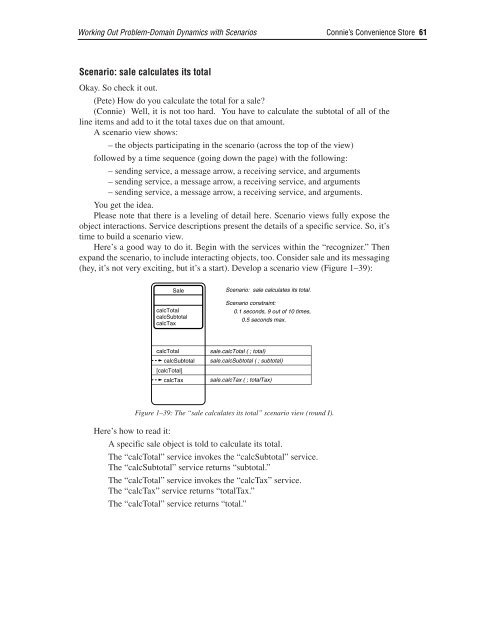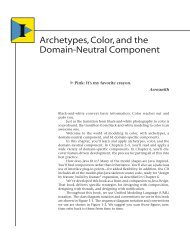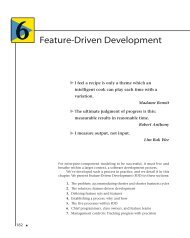Connie's Convenience Store - About Peter Coad
Connie's Convenience Store - About Peter Coad
Connie's Convenience Store - About Peter Coad
Create successful ePaper yourself
Turn your PDF publications into a flip-book with our unique Google optimized e-Paper software.
Working Out Problem-Domain Dynamics with Scenarios Connie’s <strong>Convenience</strong> <strong>Store</strong> 61<br />
Scenario: sale calculates its total<br />
Okay. So check it out.<br />
(Pete) How do you calculate the total for a sale?<br />
(Connie) Well, it is not too hard. You have to calculate the subtotal of all of the<br />
line items and add to it the total taxes due on that amount.<br />
A scenario view shows:<br />
– the objects participating in the scenario (across the top of the view)<br />
followed by a time sequence (going down the page) with the following:<br />
– sending service, a message arrow, a receiving service, and arguments<br />
– sending service, a message arrow, a receiving service, and arguments<br />
– sending service, a message arrow, a receiving service, and arguments.<br />
You get the idea.<br />
Please note that there is a leveling of detail here. Scenario views fully expose the<br />
object interactions. Service descriptions present the details of a specific service. So, it’s<br />
time to build a scenario view.<br />
Here’s a good way to do it. Begin with the services within the “recognizer.” Then<br />
expand the scenario, to include interacting objects, too. Consider sale and its messaging<br />
(hey, it’s not very exciting, but it’s a start). Develop a scenario view (Figure 1–39):<br />
Sale<br />
calcTotal<br />
calcSubtotal<br />
calcTax<br />
calcTotal<br />
calcSubtotal<br />
[calcTotal]<br />
calcTax<br />
Scenario: sale calculates its total.<br />
Scenario constraint:<br />
0.1 seconds, 9 out of 10 times,<br />
0.5 seconds max.<br />
sale.calcTotal ( ; total)<br />
sale.calcSubtotal ( ; subtotal)<br />
sale.calcTax ( ; totalTax)<br />
Figure 1–39: The “sale calculates its total” scenario view (round I).<br />
Here’s how to read it:<br />
A specific sale object is told to calculate its total.<br />
The “calcTotal” service invokes the “calcSubtotal” service.<br />
The “calcSubtotal” service returns “subtotal.”<br />
The “calcTotal” service invokes the “calcTax” service.<br />
The “calcTax” service returns “totalTax.”<br />
The “calcTotal” service returns “total.”




